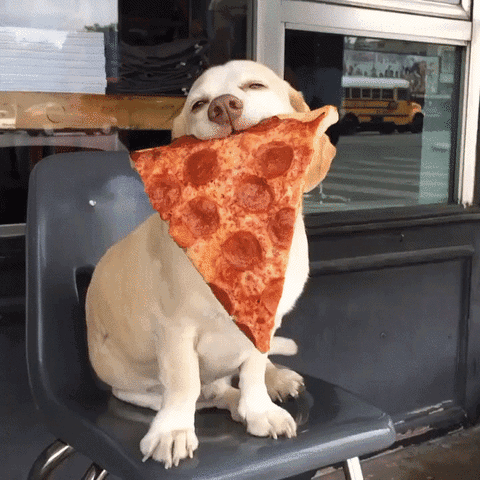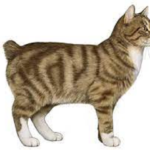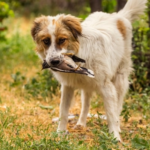Simple Constipation
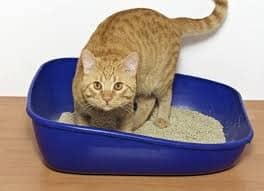
An occasional episode of constipation is not cause for alarm. Stools seem unusually hard. There is unproductive straining. Veterinary assistance may or may not be needed. Here is what you need to know:
- Why do pets get constipated? Straining unproductively can be a symptom of either constipation or large intestinal diarrhea. In either case, small amounts of mucous, gooey, or even blood-tinged stool can be passed and there is a lot of pushing involved. Difficulty urinating can also appear as straining. The point is that if all you have noticed is straining, it may not be constipation. Straining to urinate is often an emergency situation so if there is any question about the pet’s ability to urinate, see the vet right away.
- It may be tempting to buy a commercially prepared enema at the drug store and attempt to relieve the pet’s problem at home. Some commercially prepared products are toxic to pets so it is important that human constipation products, be they enemas or laxatives, not be used in pets without specific veterinary instruction.
- One of the purposes of the colon (large intestine) is the storage of stool. Many pet owners become alarmed if the pet has not passed a stool in a few days, especially in a post-anesthetic situation. In fact, the colon can easily store several weeks worth of stool so if only a few days have passed it may be worthwhile to wait a little longer.
Simple constipation can be caused by any number of reasons. Some animals excessively groom themselves (especially if they are itchy) and find themselves passing stools containing large amounts of hair. This is not an uncommon cause for constipation and often treatment for the excessive grooming is helpful.
Some animals, especially dogs, get in the habit of eating gravel, stones, dirt, bones, or plants. This does not usually indicate a dietary deficiency as many owners suspect, though we do not have a good explanation for this unusual dietary behavior. Stools produced can be sharp or painful to pass, often leading to straining and discomfort.
Some medications can have constipation as a side effect (sucralfate).
An important potential cause of constipation to check for is an electrolyte imbalance, especially in an older pet. This may be the only noticeable sign of an important metabolic problem such as kidney failure. If the constipation has been a recurring problem, then this kind of lab work database becomes especially important.
An internal obstruction may be causing the problem. For example, animals hit by cars often suffer a fractured pelvis. These usually heal without surgery but can heal such that the pelvic canal through which stool must pass is narrowed. Constipation may not result for years after the initial trauma. An old fracture is generally obvious with a radiograph of the abdomen.
Alternatively, an enlarged prostate gland is a common feature of older male dogs. The gland sits just below the colon and can press on the colon serving to narrow it. Neutering usually solves this problem, though sometimes the problem is more serious, such as a prostate tumor. An enlarged prostate is often palpable rectally though the size of the prostate is better assessed with a radiograph.
Treatment For Simple Constipation
A short course of medication may be prescribed. This might be stool softener such as laxatone, lactulose, polyethylene glycol 3350 (Miralax®), or DSS or it might be a medication to increase the normal motility (contractile strength) of the large intestine such as cisapride or bisacodyl (Dulcolax®).Simple isolated episodes of constipation are easily treated with a DSS, soap and water, or K-Y jelly based enema. It is important to appreciate that pets do not take kindly to enemas and this kind of a procedure should not be attempted at home. It invites bites and scratches, especially if the patient is uncomfortable to begin with, plus it is a messy undertaking. Enemas are best left to an experienced professional staff.
An old-fashioned remedy has been mineral oil taken orally (by mouth). It is best to avoid this temptation as mineral oil, being a light fluid without flavor, is easily inhaled accidentally into the respiratory tract. Since it is a mineral-based compound, it cannot ever be removed by the body and the immune system will forever attempt to wall it off with inflammatory granulomas.
For a single episode of constipation, a diet change may or may not be recommended. There are two approaches that are commonly employed in this regard. The first is the addition of fiber to the diet. Fiber is not absorbed by the patient’s intestinal tract and passes to the colon where it contributes to the stool volume. The result is a larger, more bulky stool which, when passed, provides stronger sensory stimulation to the colon than a regular stool. This increased stimulation may result in better colon motility. This type of diet change is achieved most easily by switching to one of the prescription high fiber diets formulated for this exact use; most manufacturers of therapeutic pet foods include such diets in their offerings. If this is not acceptable to the pet, fiber may be added to the regular diet in the form of:
- Canned pumpkin
- Bran cereal
- Metamucil, Konsyl, Siblin or similar product
Your veterinarian can instruct you as to how much you should add.
The second theory of dietary management is that the colon would perform better with a smaller stool. In this case, a low-residue, high-digestibility diet is used. With such a diet, a greater amount of nutrients is absorbed by the patient and there is less undigested material passing to the colon to contribute to the fecal mass. One of the problems in constipation is that stool becomes dry as water is absorbed by the colon, making the stool harder to pass. Fiber absorbs more water and exacerbates the problem. Low-residue diets help preserve fecal water. Such diets are generally available only through your veterinarian.
Recurring Constipation
In recurring constipation, the same treatment methods as listed above are employed but on a more long-term basis. Enemas may have to be used more frequently and medications/diet changes may represent permanent management methods. The lab work database and the abdominal radiographs become especially important.
Some additional comments regarding the long-term use of the above methods:
- Lactulose is an especially thick and overly sweet liquid and many animals find its taste objectionable (though cats are reportedly unable to taste the sweetness component). The objectionable taste frequently leads to drooling out the medicine into the fur of the chin and ruff. This may become a grooming or cosmetic problem.
- Bisacodyl works by stimulating the pelvic nerves to increase the motility of the colon. It has been suggested that this kind of nerve stimulation should not be done indefinitely, thus this medication typically is recommended in a finite course.
- Polyethylene glycol 3350 (Miralax powder) acts by pulling water from the body into the intestinal tract during stool formation, leading to a wetter, more pliant stool. The product is typically given twice daily in food and is generally well tolerated by pets though some trial and error is often needed to find an acceptable dose.
- Cisapride has a broad dose range depending on individual response. Often a more conservative dose is selected to start. If this does not appear to be effective, there is a good chance that there is room to increase the dose. Do not change a drug dose on your own! If you think the cisapride dose you have been using is ineffective, notify your veterinarian and ask if a higher dose might be a good idea.
- While neutering usually resolves most enlarged prostate problems, an old pelvic fracture may or may not necessarily be helped by surgically repairing the bones. If the above medical management is not effective, the subtotal colectomy (see below) may become needed.
Constipation Vs Obstipation
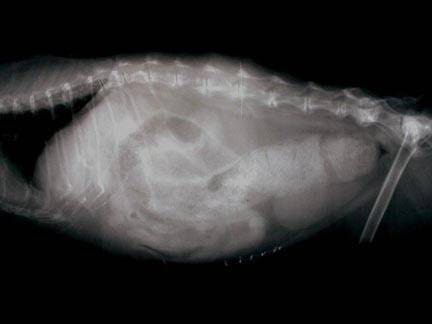
When constipation becomes a more permanent and continuous problem, it is more correct to use the term obstipation. Here, patients are unable to effectively or completely empty the colon on their own (70% of affected cats are male, 30% female). The obstipated colon is dilated and packed with an enormous, rock-hard burden of feces. The patient is usually quite uncomfortable, with more frequent unproductive straining, lethargy, appetite loss, and even vomiting entering the picture. Small hard bits of stool are often found around the house as well as in the litter box. Sometimes liquid fecal secretions are passed around the hard fecal mass, leading the owner to incorrectly think the pet has diarrhea.
Usually the only way to relieve this is through a more complete de-obstipation process, which frequently necessitates general anesthesia. The patient is hydrated, usually using fluids given under the skin and some enemas are given while the patient is awake. This helps moisten the hard fecal mass and sometimes helps with the fecal evacuation. After this, the patient is anesthetized and the fecal mass is milked from the colon by hand. If the colon is severely backed up, often a single procedure is incompletely effective as some of the stool that is higher up may not be accessible at the time of the procedure.
There is no way to predict the frequency with which this procedure must be performed in a given individual; you must simply judge the patient’s discomfort to determine this.
At some point repeated use of anesthesia may represent an undesirable expense or risk. At this point, home enemas may be reconsidered. As previously mentioned, this is a messy procedure that pets do not appreciate in the least. Your vet will need to show you the equipment and supplies as there are many different products available. The procedure will need to be done in an area that can be mopped or hosed off afterwards (an outdoor area, for example). Often the patient will require a bath afterwards. For many pet owners, this is simply not something they want to do but for some people, this can be a valuable management procedure that can save a great deal of veterinary expense.
High-fiber diets are not appropriate after a patient has progressed from simple constipation to obstipation.
Subtotal Colectomy – A Permanent Solution For Cats
For cats, a permanent resolution of this problem can be achieved by surgically removing the diseased colon though this procedure is not nearly as effective in dogs. This generally eliminates the need for any stool softeners, pills, enemas etc. and the patient can resume a low maintenance lifestyle. The constipation is replaced by a looser consistency stool and, though sometimes this firms up into a more normal consistency stool after a couple of months, it is important for an owner expect this change to be permanent. Patients appear much more comfortable with this new arrangement and most owners are so satisfied with results as to wish they had pursued surgical treatment sooner.
Still, it is important to realize that the subtotal colectomy is a major surgery and there are special problems to be concerned about:
- The colon’s bacterial population is enormous (some ten times higher than the population of the small intestine). This introduces special concern for any leaking from the intestinal incision. Infection could easily progress to peritonitis and become a lethal complication. This is by no means a common problem but it is important to report any post-operative lethargy or appetite issues immediately, especially if the patient had appeared to be stabilizing and the change is sudden. Leaking after intestinal surgery generally occurs around the third day after surgery if it is going to occur. Fever is a sign of infection but it is best not to attempt to take a rectal temperature at home given the proximity of the colon incision. Your cat will probably be going home on antibiotics.
- Specific diets are often recommended during the recovery period, usually something highly digestible to minimize the amount of stool produced. The 20% of cats who have persistent loose stool problems generally must stay on this diet permanently.
- It is not unusual for a patient to refuse food for several days after surgery. The cat must not be allowed to go without food for more than five days without some kind of nutritional support. This may require feeding through a tube.
- Scarring of the surgery site (stricture) may lead to narrowing of the bowel and recurrence of the obstipation. If this occurs a second surgery would be necessary to remove the narrowed area.
Most cats do not experience complications with this surgery beyond the initial loose stool mentioned. Results are described as good to excellent.
